Glint Removal Assessment to Estimate the Remote Sensing Reflectance in Inland Waters with Widely Differing Optical Properties
Abstract
:1. Introduction
2. Materials and Methods
2.1. Tietê River Cascade System of Reservoirs (TCSR)
2.2. In Situ Dataset
2.2.1. Water Quality Parameters
2.2.2. Optical Data
2.2.3. Inherent Optical Properties
2.3. Remote Sensing Reflectance
2.4. HydroLight Simulations
2.5. Accuracy Assessment of Rrs
2.6. OLI Assessment
3. Results
3.1. Water Quality Data and Optical Characterization
3.2. Rrs from M1, M2, M3, and M4 Approaches
3.3. OLI Rrs Versus Glint Removal Rrs_M3
4. Discussion
5. Conclusions
Author Contributions
Funding
Acknowledgments
Conflicts of Interest
References
- Zibordi, G.; Ruddick, K.; Ansko, I.; Moore, G.; Kratzer, S.; Icely, J.; Reinart, A. In situ determination of the remote sensing reflectances: An inter-comparison. Ocean Sci. 2012, 567–586. [Google Scholar] [CrossRef]
- Garaba, S.P.; VoB, D.; Wollschlager, J.; Zielinski, O. Modern approaches to shipborne ocean color remote sensing. Appl. Opt. 2015, 54, 3602–3613. [Google Scholar] [CrossRef]
- Zhang, X.; He, S.; Shabani, A.; Zhai, P.; Du, K. Spectral sea surface reflectances of skylight. Opt. Exp. 2017, 25, 1–13. [Google Scholar] [CrossRef] [PubMed]
- IOCCG. Atmospheric Correction for Remotely-Sensed Ocean-Colour Products, Reports of the International Ocean-Colour Coordinating Group; Report Number 10; IOCCG: Busan, Korea, 2010. [Google Scholar]
- Lee, Z.; Ahn, Y.; Mobley, C.; Arnone, R. Removal of surface-reflected light for the measurements of remote-sensing reflectance from an above-surface platform. Opt. Exp. 2010, 18, 26313–26324. [Google Scholar] [CrossRef] [PubMed]
- Gordon, H.R.; Brown, O.B.; Jacobs, M.M. Computed relationships between the inherent and apparent optical properties of a flat, homogenous ocean. Appl. Opt. 1975, 14, 417–427. [Google Scholar] [CrossRef] [PubMed]
- Mobley, C. Estimation of the remote-sensing reflectance from above-surface measurements. Appl. Opt. 1999, 38, 7442–7455. [Google Scholar] [CrossRef] [PubMed]
- Mobley, C. Polarized reflectance and transmittance properties of windblown sea surfaces. Appl. Opt. 2015, 54, 4828–4849. [Google Scholar] [CrossRef] [PubMed]
- Ruddick, K.G.; de Cauwer, V.; Park, Y.; Moore, G. Seaborne measurements of near infrared water-leaving reflectance: The similarity spectrum for turbid waters. Limnol. Oceanogr. 2006, 51, 1167–1179. [Google Scholar] [CrossRef] [Green Version]
- Fougnie, B.; Frouin, R.; Lecomte, P.; Deschamps, P.-Y. Reduction of skylight reflection effects in the above water measurement of diffuse marine reflectance. Appl. Opt. 1999, 38, 3844–3856. [Google Scholar] [CrossRef] [PubMed]
- Gilerson, A.; Carrizo, C.; Foster, R.; Harmel, T. Variability of the reflectance coefficient of skylight from the ocean surface and its implications to ocean color. Opt. Exp. 2018, 26, 9615–9633. [Google Scholar] [CrossRef] [PubMed]
- Dev, P.J.; Shanmugam, P. A new theory and its application to remove the effect of surface-reflected light in above-surface radiance data from clear and turbid waters. J. Quant. Spectrosc. Radiat. Transf. 2014, 142, 75–92. [Google Scholar] [CrossRef]
- Kay, S.; Hedley, J.D.; Lavender, S. Sun glint correction of high and low spatial resolution images of aquatic scenes: A review of methods for visible and near-infrared wavelengths. Remote Sens. 2009, 1, 697–730. [Google Scholar] [CrossRef]
- Kutser, T.; Vahtmae, E.; Paavel, B.; Kauer, T. Removing glint effects from field radiometry data measured in optically complex coastal and inland waters. Remote Sens. Environ. 2013, 133, 85–89. [Google Scholar] [CrossRef]
- Hooker, S.B.; Lazin, G.; Zibordi, G.; McLean, S. An evaluation of above- and in-water methods for determining water leaving radiances. J. Atmos. Ocean. Technol. 2002, 19, 486–515. [Google Scholar] [CrossRef]
- Wei, J.; Lee, Z.; Shang, S. A system to measure the data quality of spectral remote-sensing reflectance of aquatic environments. J. Geophys. Res. Oceans 2016, 121, 8189–8207. [Google Scholar] [CrossRef]
- Lee, Z.; Pahvelan, N.; Ahn, Y.; Greb, S.; O’Donnell, D. Robust approach to directly measuring water-leaving radiance in the field. Appl. Opt. 2013, 52, 1693–1701. [Google Scholar] [CrossRef] [PubMed]
- Lee, Z.; Lubac, B.; Werdell, J.; Arnone, R. An Update of the Quasi-Analytical Algorithm (QAA_v5) [WWW Document]. 2009. Available online: http://www.ioccg.org/groups/Software_OCA/QAA_v5.pdf (accessed on 12 August 2018).
- Lee, Z.; Weidemann, A.; Kindle, J.; Arnone, R.; Carder, K.L.; Davis, C. Euphotic zone depth: Its derivation and implication to ocean-color remote sensing. J. Geophys. Res. 2007, 112, C03009. [Google Scholar] [CrossRef]
- Bukata, R.; Jerome, J.; Kondratyev, K.Y.; Pozdnyakov, D.V. Optical Properties and Remote Sensing of Inland and Coastal Waters, 1st ed.; CRC Press: Boca Raton, FL, USA, 1995. [Google Scholar]
- Watanabe, F.S.Y.; Alcântara, E.; Imai, N.; Rodrigues, T.; Bernardo, N. Estimation of Chlorophyll-a Concentration from Optimizing a Semi-Analytical Algorithm in Productive Inland Waters. Remote Sens. 2018, 10, 227. [Google Scholar] [CrossRef]
- Prado, R.B.; Novo, E.M.L.M. Modeling pollution potential input from the drainage basin into Barra Bonita reservoir, São Paulo—Brazil. Braz. J. Biol. 2015, 75, 314–323. [Google Scholar] [CrossRef] [PubMed]
- Tonietto, A.E.; Lombardi, A.T.; Choueri, R.B.; Vieira, A.A. Chemical behavior of Cu, Zn, Cd, and Pb in a eutrophic reservoir: Speciation and complexation capacity. Environ. Sci. Pollut. Res. 2015, 22, 15920–15930. [Google Scholar] [CrossRef] [PubMed]
- Barrella, W.; Petrere, M., Jr. Fish community alterations due to pollution and damming in Tietê and Paranapanema rivers (Brazil). River Res. Appl. 2003, 19, 59–76. [Google Scholar] [CrossRef]
- Barbosa, F.A.R.; Padisak, J.; Espindola, E.L.G.; Borics, G.; Rocha, O. The cascading reservoir continuum concept (CRCC) and its application to the river Tietê-basin, São Paulo State, Brazil. Theor. Reserv. Ecol. Appl. 1999, 1, 425–437. [Google Scholar]
- Cairo, C.T.; Barbosa, C.C.F.; Novo, E.M.L.M.; Calijuri, M.C. Spatial and seasonal variation in diffuse attenuation coefficients of downward irradiance at Ibitinga Reservoir, São Paulo, Brazil. Hydrobiologia 2017, 784, 265–282. [Google Scholar] [CrossRef]
- Rodrigues, T.; Alcântara, E.; Watanabe, F.; Imai, N. Retrieval of Secchi disk depth from a reservoir using semi-analytical scheme. Remote Sens. Environ. 2017, 198, 213–228. [Google Scholar] [CrossRef]
- Rodrigues, T.W.P.; Guimarães, U.S.; Rotta, L.H.S.; Watanabe, F.S.Y.; Alcântara, E.; Imai, N.N. Sampling design in reservoirs based on Landsat-8/OLI images: A case study in Nova Avanhandava reservoir (São Paulo State, Brazil). Boletim de Ciências Geodésicas 2016, 22, 303. [Google Scholar] [CrossRef]
- APHA (American Public Health Association); AWWA (American Water Works Association); WEF (Water Environmental Federation). Standard Methods for the Examination of Water and Wastewater, 20th ed.; APHA; AWWA; WEF: Washington, DC, USA, 1998. [Google Scholar]
- Golterman, H.L.; Clymo, R.S.; Ohnstad, M.A.M. Methods for Physical and Chemical Analysis of Freshwater; Blackwell Scientific Publications: Oxford, UK, 1978. [Google Scholar]
- Mueller, J.L. In-water radiometric profile measurements and data analysis protocols. In Ocean Optics Protocols for Satellite Ocean Color Sensor Validation; Fargion, G.S., Mueller, J.L., Eds.; NASA Tech. Memo, Goddard Space Flight Center: Greenbelt, MD, USA, 2000; pp. 87–97. [Google Scholar]
- Tassan, S.; Ferrari, G.M. An alternative approach to absorption measurements of aquatic particles retained on filters. Limnol. Oceanogr. 1995, 40, 1358–1368. [Google Scholar] [CrossRef] [Green Version]
- Tassan, S.; Ferrari, G.M. Measurement of light absorption by aquatic particles retained on filters: Determination of the optical path length amplification by the “transmittance reflectance” method. J. Plankton Res. 1998, 20, 1699–1709. [Google Scholar] [CrossRef]
- Tilstone, G.; Moore, G.F.; Sørensen, K.; Doerffer, R.; Røttgers, R.; Ruddick, K.G.; Pasterkamp, R.; Jørgernsen, P.V. REVAMP, Regional Validation of MERIS Chlorophyll Products in North Sea Coastal Waters, Protocols; European Union FPV: City of Brussels, Belgium, 2002; 68p. [Google Scholar]
- Garaba, S.P.; Zielinski, O. Comparison of remote sensing reflectance from above-water and in-water measurements west of Greenland, Labrador Sea, Denmark Strait and west of Iceland. Appl. Opt. 2013, 21, 15938–15950. [Google Scholar] [CrossRef] [PubMed]
- Lee, Z.; Carder, K.L.; Arnone, R.A. Deriving inherent optical properties from water color: A multiband quasi-analytical algorithm for optically deep waters. Appl. Opt. 2002, 41, 5755–5772. [Google Scholar] [CrossRef] [PubMed]
- Mobley, C.D.; Sundman, L.K. HydroLight 5.2—EcoLight 5.2 Users’ Guide; Sequoia Scientific, Inc.: Bellevue, WA, USA, 2013. [Google Scholar]
- Kruse, F.A.; Lefkoff, A.B.; Dietz, J.B. Expert System-Based Mineral Mapping in Northern Death Valley, California/Nevada, Using the Airbone Visible/Infrared Imaging Spectrometer (AVIRIS). Remote Sens. Environ. 1993, 44, 309–336. [Google Scholar] [CrossRef]
- Pope, R.M.; Fry, E.S. Absorption spectrum (380–700 nm) of pure water. II Integrating cavity measurements. Appl. Opt. 1997, 36, 8710–8723. [Google Scholar] [CrossRef] [PubMed]
- Smith, R.C.; Baker, K.S. Optical properties of the clearest natural waters (200–800 nm). Appl. Opt. 1981, 20, 177–184. [Google Scholar] [CrossRef] [PubMed]
- Garaba, S.P.; Zielinski, O. Methods in reducing surface reflected glint for shipborne above-water remote sensing. J. Eur. Opt. Soc. Rapid Publ. 2013, 8. [Google Scholar] [CrossRef] [Green Version]
- Toole, D.A.; Siegel, D.A.; Menzies, D.W.; Neumann, M.J.; Smith, R.C. Remote sensing reflectance determinations in the coastal ocean environment: Impact of instrumental characteristics and environmental variability. Appl. Opt. 2000, 39, 456–469. [Google Scholar] [CrossRef] [PubMed]
- Lehmann, M.K.; Nguyen, U.; Allan, M.; van der Woerd, H. Colour classification of 1486 lakes across a wide range of optical water types. Remote Sen. 2018, 10, 1273. [Google Scholar] [CrossRef]
- Alcântara, E.; Curtarelli, M.; Kampel, M.; Stech, J. Spatiotemporal total suspended matter estimation in Itumbiara Reservoir with Landsat 8/OLI images. Int. J. Cartogr. 2016, 7, 761–770. [Google Scholar] [CrossRef]
- Vanhellemont, Q.; Ruddick, K.G. Advantages of high quality SWIR bands for ocean colour processing: Examples from Landsat-8. Remote Sens. Environ. 2015, 161, 89–106. [Google Scholar] [CrossRef]
- Bernardo, N.; Watanabe, F.; Pequeno, T.; Alcântara, E. Atmospheric correction issues for retrieving total suspended matter concentrations in inland waters using OLI/Landsat-8 image. Adv. Space Res. 2017, 59, 2335–2348. [Google Scholar] [CrossRef]
- Pahlevan, N.; Schott, J.R. Leveraging EO-1 to evaluate capability of new generation of Landsat sensors for coastal/inland water studies. IEEE J. Sel. Top. Appl. Earth Observ. Remote Sens. 2013, 6, 360–374. [Google Scholar] [CrossRef]
- Mouw, C.B.; Greb, S.; Aurin, D.; DiGiacomo, P.M.; Lee, Z.; Twardowski, M.; Binding, C.; Hu, C.; Ma, R.; Moore, T.; et al. Aquatic color radiometry remote sensing of coastal and inland waters: Challenges and recommendations for future satellite missions. Remote Sens. Environ. 2015, 160, 15–30. [Google Scholar] [CrossRef]
- Barsi, J.; Lee, K.; Kvaran, G.; Markham, B.; Pedelty, J. The spectral response of the Landsat-8 operational land imager. Remote Sens. 2014, 6, 10232–10251. [Google Scholar] [CrossRef]
- Palmer, S.C.J.; Kutser, T.; Hunter, P.D. Remote sensing of inland waters: Challenges, progress, and future directions. Remote Sens. Environ. 2015, 157, 1–8. [Google Scholar] [CrossRef]
- Watanabe, F.S.Y.; Mishra, D.R.; Astuti, I.; Rodrigues, T.W.P.; Alcantara, E.; Imai, N.N.; Barbosa, C.C.F. Parametrization and calibration of a quasi-analytical algorithm for tropical eutrophic waters. ISPRS J. Photogramm. Remote Sens. 2016, 121, 28–47. [Google Scholar] [CrossRef]
- Kirk, J.T.O. Light and Photosynthesis in Aquatic Systems, 3rd ed.; Cambrige University Press: Cambrige, UK, 2011. [Google Scholar]
- Brezonik, P.L.; Olmanson, L.G.; Finlay, J.C.; Bauer, M.E. Factor affecting the measurement of CDOM by remote sensing of optically complex inland waters. Remote Sens. Environ. 2015, 157, 199–215. [Google Scholar] [CrossRef]
- Estapa, M.L.; Boss, E.; Mayer, L.M.; Roesler, C.S. Role of iron and organic carbon in mass-specific light absorption by particulate matter from Louisiana coastal waters. Limnol. Oceanogr. 2012, 57, 97–112. [Google Scholar] [CrossRef]
- Xiao, Y.H.; Räike, A.; Hartikainen, H.; Vähätalo, A.V. Iron as a source of color in river waters. Sci. Total Environ. 2015, 536, 914–923. [Google Scholar] [CrossRef] [PubMed]
- Kutser, T.; Paavel, B.; Verpoorter, C.; Ligi, M.; Soomets, T.; Toming, K.; Casal, G. Remote sensing of Black Lakes and using 810 nm reflectances peak for retrieving water quality parameters of optically complex waters. Remote Sens. 2016, 8, 497. [Google Scholar] [CrossRef]
- Han, L.; Rundquist, D.C. Comparison of NIR/RED ratio and first derivative of reflectance in estimating algal-chlorophyll concentration: A case study in a turbid reservoir. Remote Sens. Environ. 1997, 62, 253–261. [Google Scholar] [CrossRef]
- Doxaran, D.; Froidefone, J.; Castaing, P. A reflectance band ratio used to estimate suspended matter concentrations in sediment-dominated coastal waters. Int. J. Remote Sens. 2002, 23, 5079–5085. [Google Scholar] [CrossRef]
- Kutser, T.; Vahtmäe, E.; Praks, J. A sun glint correction method for hyperspectral imagery containing areas with non-negligible water leaving NIR signal. Remote Sens. Environ. 2009, 113, 2267–2274. [Google Scholar] [CrossRef]
- Gomes, A.C.C.; Bernardo, N.; Alcântara, E. Accessing the southeastern Brazil 2014 drought severity on the vegetation health by satellite image. Nat. Hazards 2017, 89, 1401–1420. [Google Scholar] [CrossRef]
- Li, L.; Li, L.; Song, K.; Li., Y.; Tedesco, L.P.; Shi, K.; Li, Z. An inversion model for deriving optical properties of inland waters: Establishment, validation and application. Remote Sens. Environ. 2013, 135, 150–166. [Google Scholar] [CrossRef]
- Pahlevan, N.; Lee, Z.; Wei, J.; Schaaf, C.B.; Schott, J.R.; Erk, A. On-orbit radiometric characterization of OLI (Landsat-8) for applications in aquatic remote sensing. Remote Sens. Environ. 2014, 154, 272–284. [Google Scholar] [CrossRef]
- Bernardo, N.; Watanabe, F.; Rodrigues, T.; Alcântara, E. Evaluation of the suitability of MODIS, OLCI and OLI for mapping the distribution of total suspended matter in the Barra Bonita Reservoir (Tietê River, Brazil). Remote Sens. Appl. Soc. Environ. 2016, 4, 68–82. [Google Scholar] [CrossRef]
- Vanhellemont, Q.; Ruddick, K.G. Turbid wakes associated with offshore wind turbines observed with Landsat 8. Remote Sens. Environ. 2014, 145, 105–115. [Google Scholar] [CrossRef]
- Lee, Z.; Shang, S.; Qi, L.; Yan, J.; Lin, G. A semi-analytical scheme to estimate Secchi-disk depth from Landsat-8 measurements. Remote Sens. Environ. 2017, 177, 101–106. [Google Scholar] [CrossRef]
- Alcântara, E.; Bernardo, N.; Rodrigues, T.; Watanabe, F. Modeling the spatio-temporal dissolved organic carbon concentration in Barra Bonita reservoir using OLI/Landsat-8 images. Model. Earth Syst. Environ. 2017, 3, 1–11. [Google Scholar] [CrossRef]
- Bernardo, N.; Alcântara, E. Comparing proximal remote sensing and orbital images to estimate the total suspended matter in inland water. Model. Earth Syst. Environ. 2017, 3, 1–8. [Google Scholar] [CrossRef]
- Kutser, T.; Pierson, D.C.; Kallio, K.Y.; Reinart, A.; Sobek, S. Mapping lake CDOM by satellite remote sensing. Remote Sens. Environ. 2005, 94, 535–540. [Google Scholar] [CrossRef]
- Matthews, M.W. A current review of empirical procedures of remote sensing in inland and near-coastal transitional waters. Int. J. Remote Sens. 2011, 32, 6855–6899. [Google Scholar] [CrossRef]
- Zhu, W.; Yu, Q.; Tian, Y.Q.; Becker, B.L.; Zheng, T.; Carrick, H.J. An assessment of remote sensing algorithms for colored dissolved organic matter in complex freshwater environments. Remote Sens. Environ. 2014, 140, 766–778. [Google Scholar] [CrossRef]
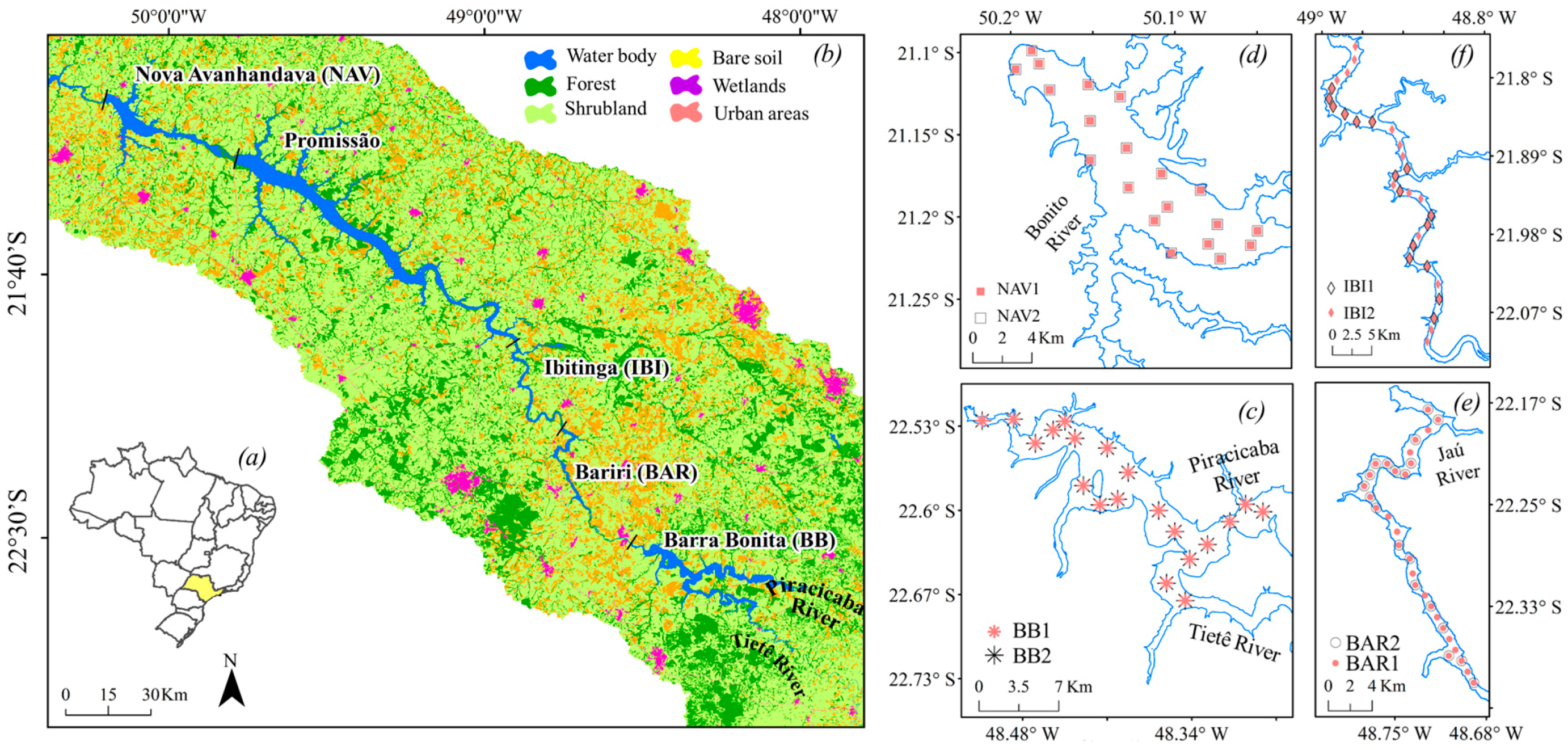
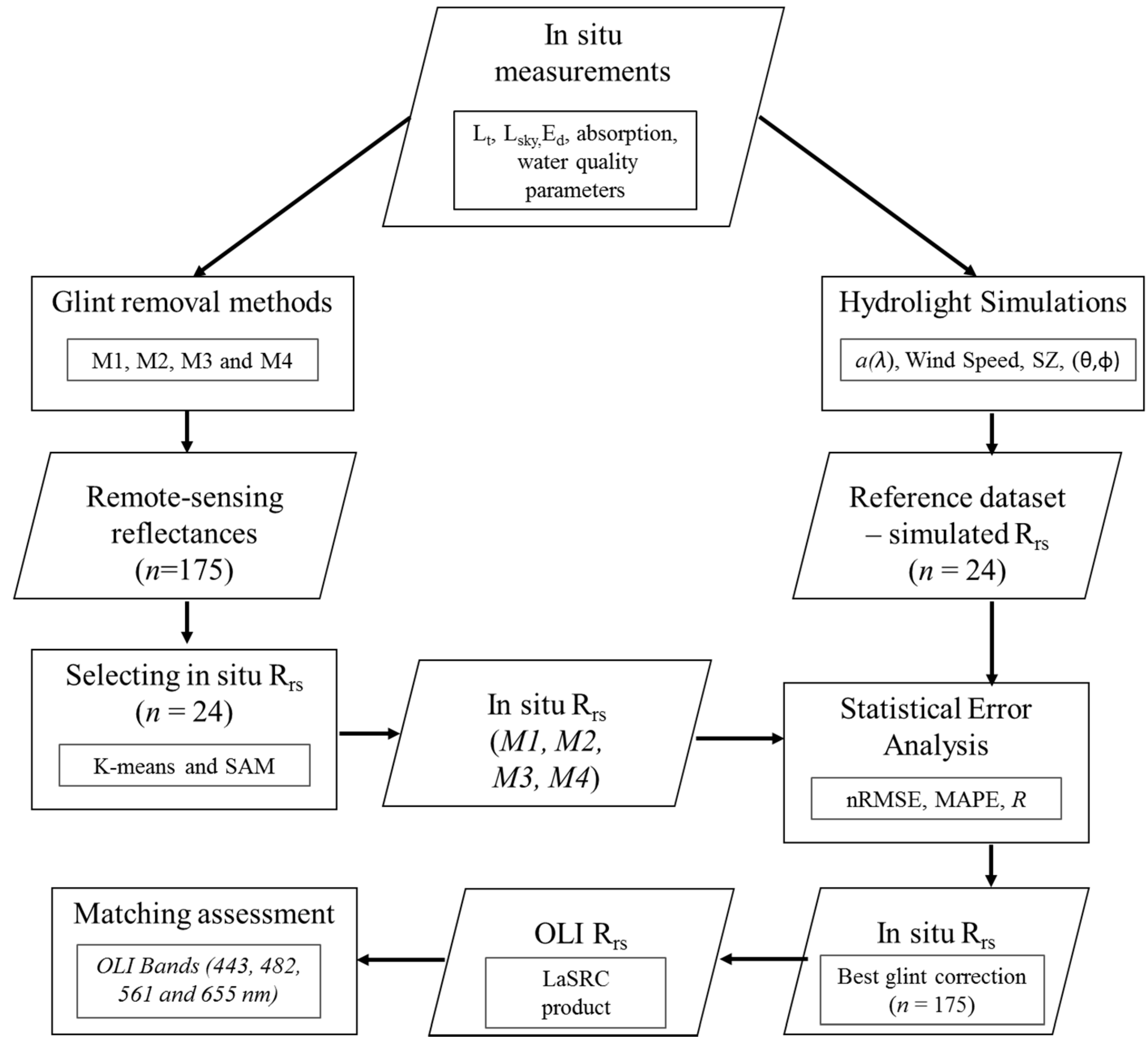
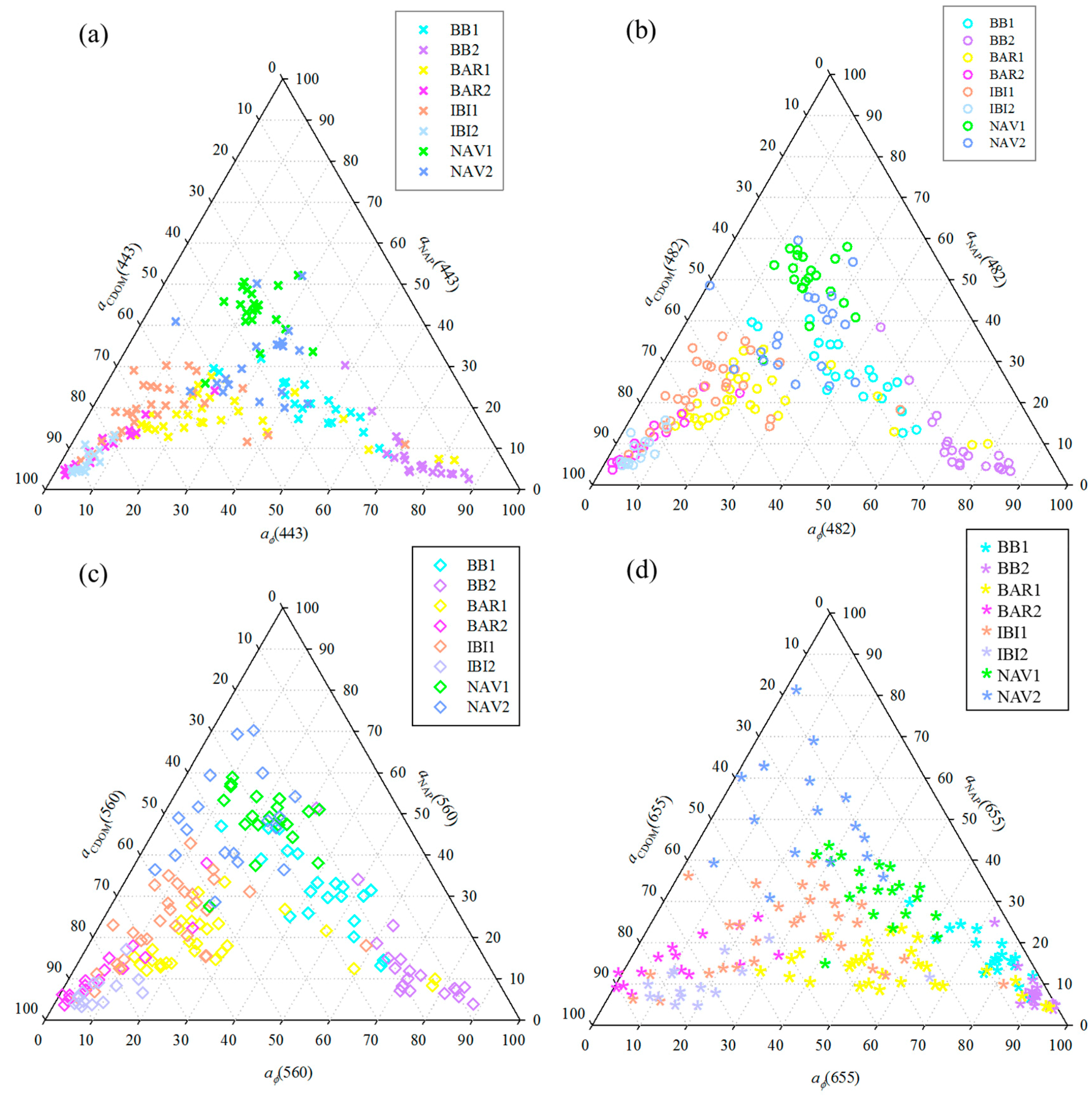
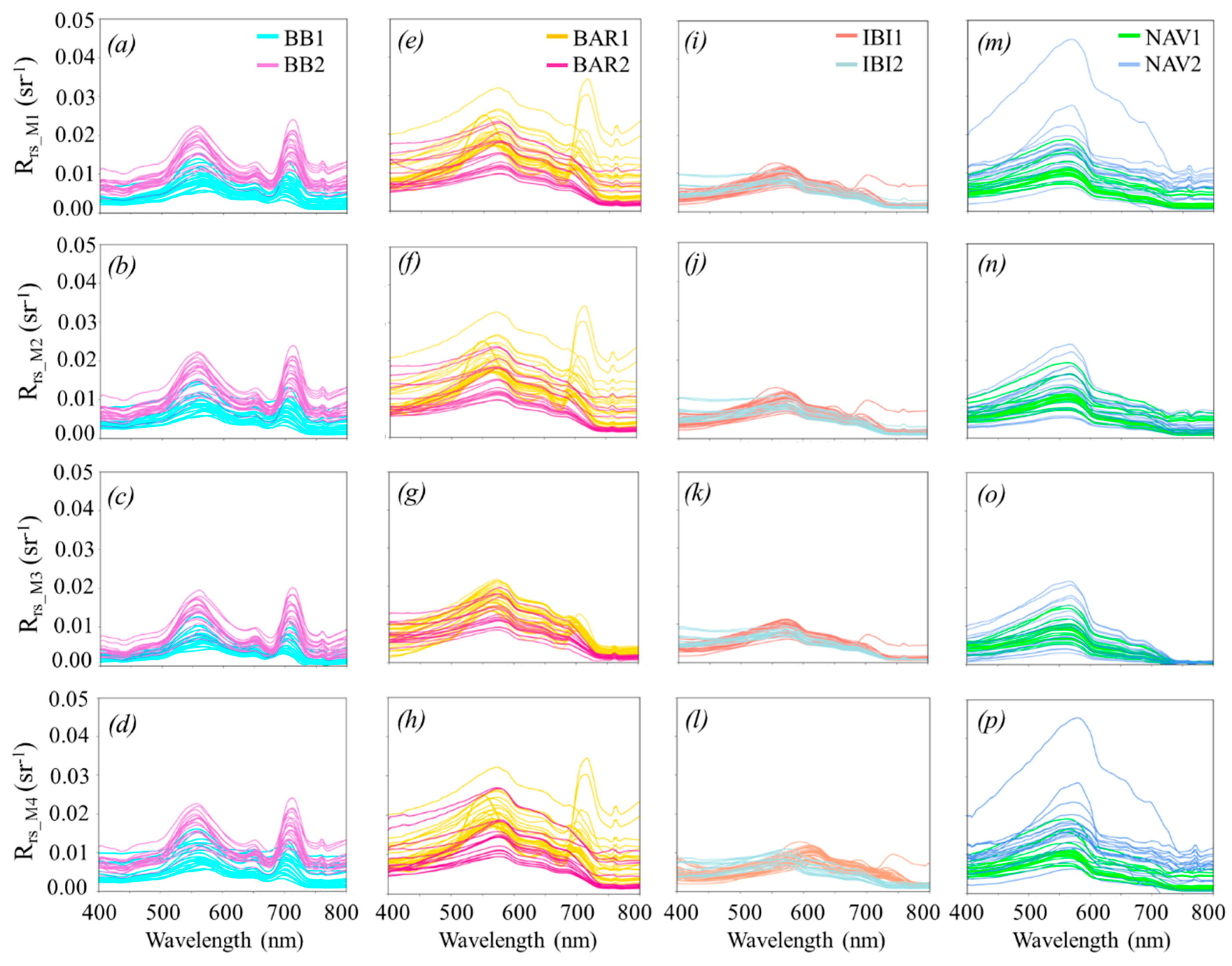
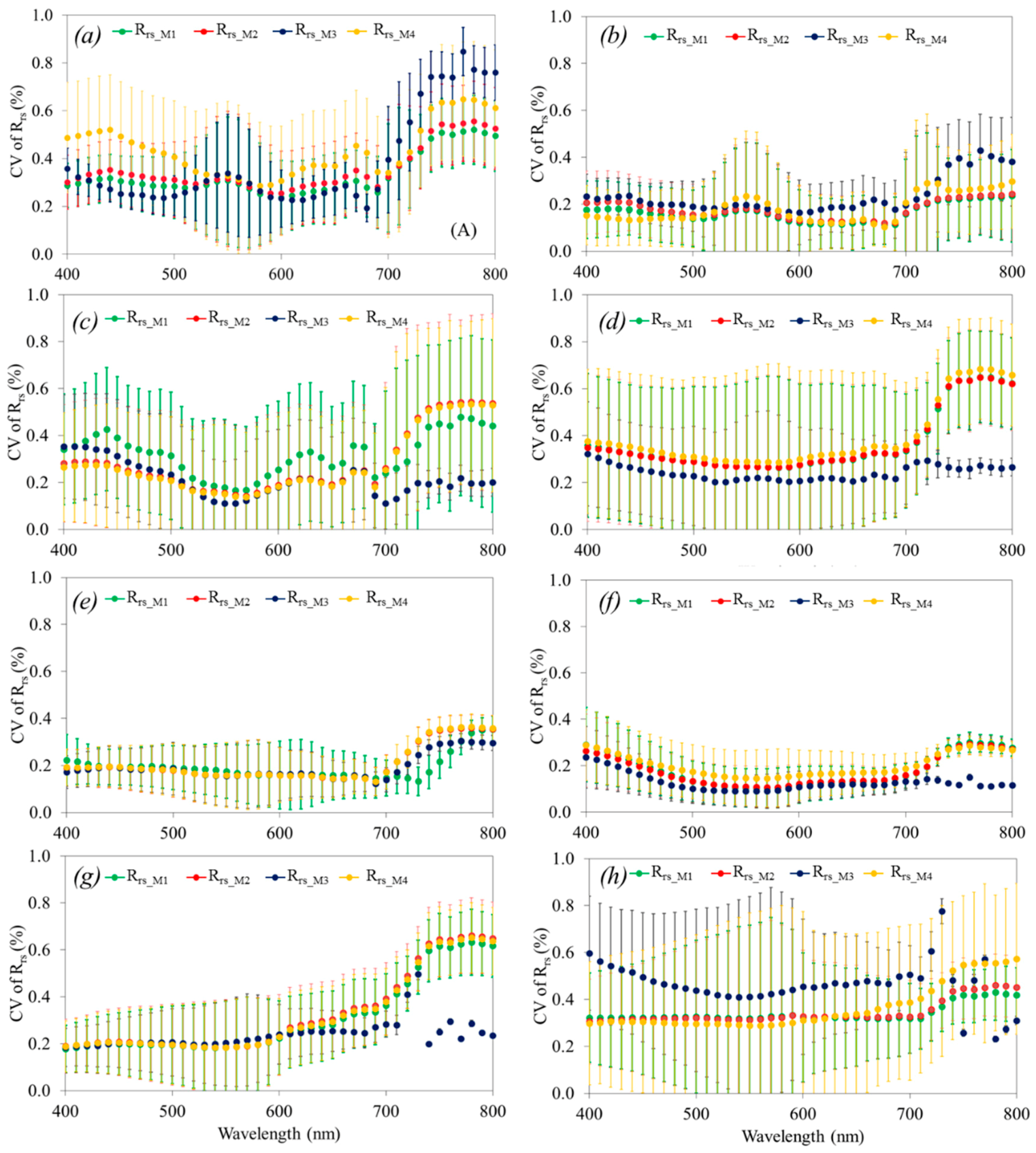
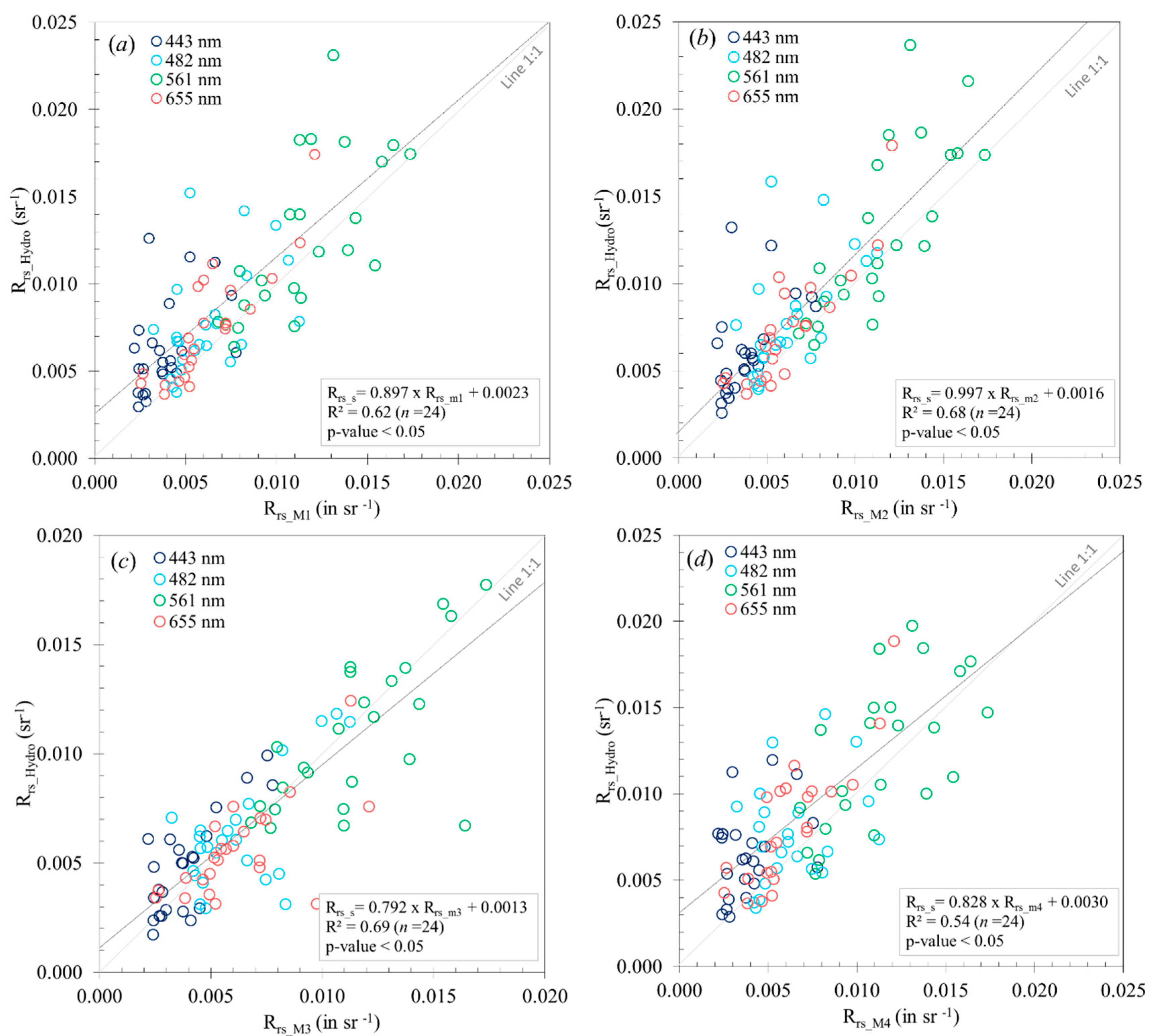
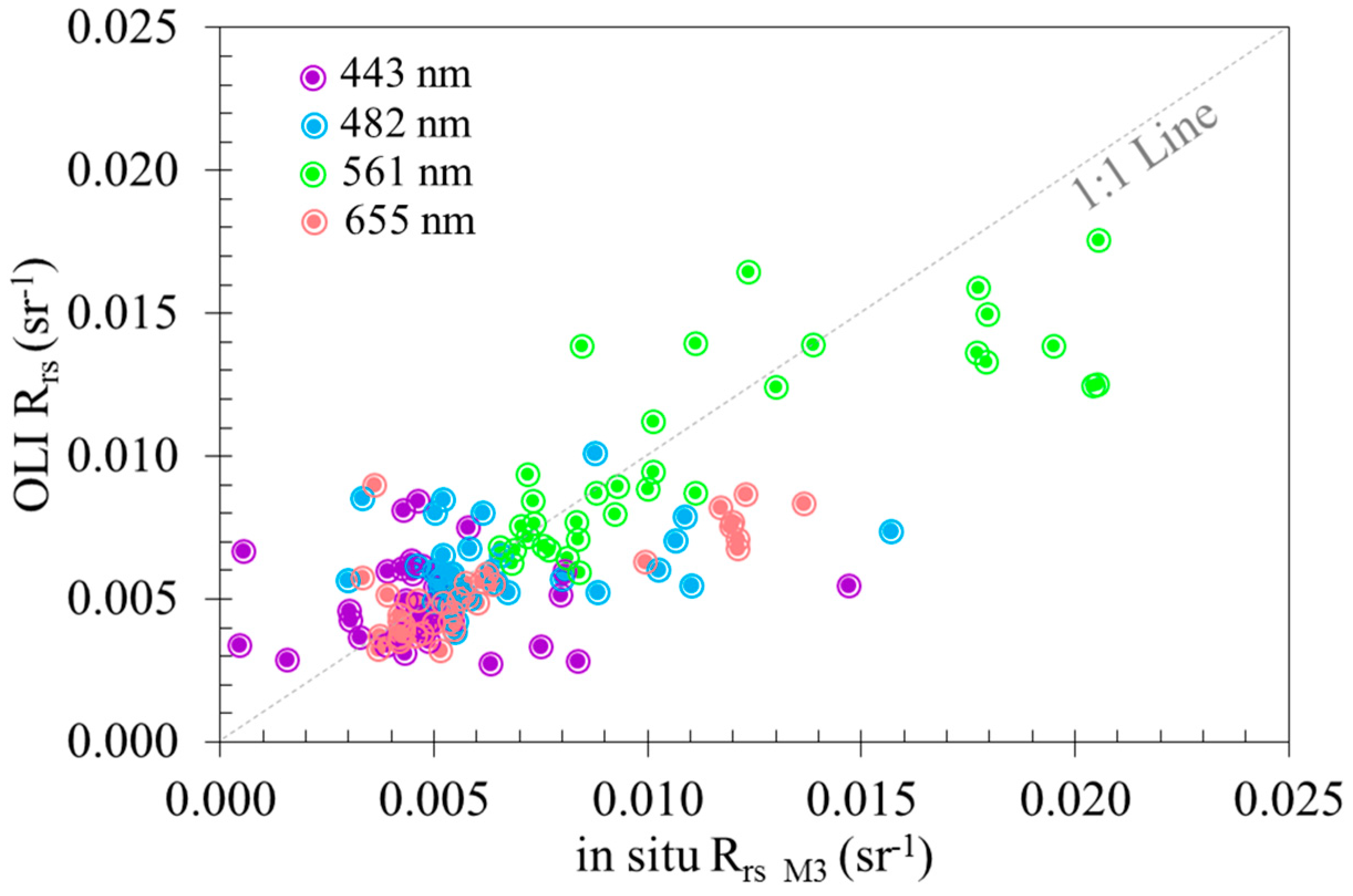
| Field Campaign | ID | n | Time Acquisition | Radiometric Measurements | Water Quality and Physical Parameters |
|---|---|---|---|---|---|
| Barra Bonita HR | BB1 | 20 | May 2014 | Lt, Lsky Es, Ed(z) acdom, aphy, anap | Turbidity, ZSD, SPM, PIM, POM, Chl-a, Wind Speed and Depth. |
| BB2 | 20 | October 2014 | |||
| Bariri HR | BAR1 | 30 | August 2016 | ||
| BAR2 | 18 | June 2017 | |||
| Ibitinga HR | IBI1 | 30 | July 2016 | ||
| IBI2 | 16 | June 2017 | |||
| Nova Avanhandava HR | NAV1 | 20 | May 2014 | ||
| NAV2 | 20 | September 2014 |
| GRM | Benefits | Disadvantages |
|---|---|---|
| M1 [7] |
|
|
| M2 [8] |
|
|
| M3 [5] |
|
|
| M4 [9] |
|
|
| OSC | Description | Notation | Unit | TCSR’s Database | Test Data |
|---|---|---|---|---|---|
| Water | Number of Rrs spectra | N | - | 175 | 24 |
| Wavelengths | λ | nm | 400:1:900 | 400:1:800 | |
| Absorption and scattering coefficients of pure water | aw,bw | m−1 | Pope and Fry (1997) and Smith and Baker (1981) | ||
| Water temperature | T | °C | 21.1–39.4 | 21.8–29.2 | |
| Chlorophyll-bearing particles | Chlorophyll-a concentration | Chl-a | mg.m−3 | 1.37–797.8 | 2.46–710.00 |
| Specific absorption coefficient | a*phy | m2mg−1 | Laboratory data | ||
| Scattering coefficient Chl-a | b phy | m−1 | Standard power law | ||
| Scattering phase function | β phy | sr−1 | Average particle (Petzold’s phase Function) | ||
| Colored Dissolved Organic Matter (CDOM) | absorption coefficient of CDOM at 440 nm | acdom(440) | m−1 | 0.20–2.29 | 0.20–2.20 |
| Slope of CDOM absorption | Scdom | nm−1 | 0.004–0.018 | 0.004–0.0172 | |
| Non-algae particles (NAP) | NAP concentration | NAP | g.m−3 | 0.10–4.4 | 0.10–3.00 |
| Specific absorption coefficient at 440 | a*NAP | m2mg−1 | Laboratory data | ||
| Scattering coefficient by NAP | b NAP | m−1 | Standard power law (Loiser and Morel near surface) | ||
| Scattering phase function | β NAP | sr−1 | 0.015–0.03 | ||
| TCSR | |||||
|---|---|---|---|---|---|
| BB1 (n = 20) | BAR1 (n = 30) | IBI1 (n = 30) | NAV1 (n = 20) | ||
| SPM (mg·L−1) | Min-MaxAver Aver ± SD CV (%) | 3.6–16.3 7.2 ± 3.3 45.2 | 3.6–40.3 8.3 ± 4.5 54.8 | 1.0–8.1 2.6 ± 1.0 39.2 | 0.1–2.6 1.0 ± 0.6 61.7 |
| PIM (mg·L−1) | Min-Max Aver ± SD CV (%) | 0.2–4.4 1.1 ± 0.9 78.8 | 0.9–4.0 2.3 ± 0.5 21.4 | 0.3–2.6 0.8 ± 0.3 35.3 | 0.1–2.2 0.7 ± 0.5 76.7 |
| POM (mg·L−1) | Min-Max Aver ± SD CV (%) | 2.8–14.7 6.1 ± 3.2 52.0 | 1.4–36.3 5.9 ± 4.5 75.1 | 0.5–6.0 1.8 ± 0.9 49.6 | 0.2–0.9 0.5 ± 0.2 40.8 |
| Chl-a (mg·m−3) | Min-Max Aver ± SD CV (%) | 17.7–279.9 120.4 ± 70.3 58.4 | 25.7–709.9 119.8 ± 96.4 80.5 | 1.4–119.0 21.8 ± 18.7 86.0 | 2.5–12.6 6.2 ± 2.5 40.0 |
| Turbidity (NTU) | Min-Max Aver ± SD CV (%) | 1.7–12.5 5.2 ± 2.4 47.0 | 7.8–80.9 16.6 ± 7.6 45.8 | 2.8–8.9 4.3 ± 0.8 17.9 | 1.0–2.5 1.7 ± 0.4 25.4 |
| ZSD (m) | Min-Max Aver ± SD CV (%) | 0.8–2.3 1.5 ± 0.4 28.9 | 0.5–1.6 1.2 ± 0.2 20.0 | 1.6–3.2 2.2 ± 0.2 10.9 | 2.3–4.8 3.2 ± 0.6 20.0 |
| Wind Speed (m·s−1) | Min-Max Aver ± SD CV (%) | 0.6–4.9 1.8 ± 1.1 57.8 | 0.5–8.0 2.5 ± 2.3 90.3 | 0.0–6.0 2.2 ± 1.2 54.5 | 2.0–6.4 3.6 ± 1.3 36.8 |
| BB2 (n = 20) | BAR2 (n = 18) | IBI2 (n = 16) | NAV2 (n = 20) | ||
| SPM (mg·L-1) | Min-Max Aver ± SD CV (%) | 10.8–44.0 21.9 ± 7.04 32.0% | 0.20–2.6 1.6 ± 0.44 42.4 | 0.20–2.20 1.06 ± 0.57 53.5 | 0.50–2.80 1.00 ± 0.38 37.6 |
| PIM (mg·L-1) | Min-Max Aver ± SD CV (%) | 0.6–3.8 2.60 ± 0.96 37.3 | 0.20–1.30 0.60 ± 0.24 42.4 | 0.20–1.00 0.40 ± 0.24 61.8 | 0.30–1.10 0.50 ± 0.14 26.5 |
| POM (mg·L−1) | Min-Max Aver ± SD CV (%) | 10.2–30.4 18.2 ± 4.8 26.2 | 0.40–1.60 1.10 ± 0.32 28.8 | 0.30–1.90 0.93 ± 0.46 49.8 | 0.14–2.00 0.50 ± 0.34 65.8 |
| Chl-a (mg·m−3) | Min-Max Aver ± SD CV (%) | 263.2–797.8 428.7 ± 154.5 80.5 | 3.8–19.0 8.0 ± 3.27 40.9 | 2.50–13.7 6.64 ± 4.46 67.2 | 4.51–20.5 9.01 ± 3.15 34.9 |
| Turbidity (NTU) | Min-Max Aver ± SD CV (%) | 11.6–33.2 18.6 ± 7.6 45.8 | 3.50–8.80 5.70 ± 1.25 10.9 | 1.85–3.60 2.47 ± 0.52 21.1 | 1.01–2.56 1.73 ± 0.33 18.9 |
| ZSD (m) | Min-Max Aver ± SD CV (%) | 0.37–0.78 0.57 ± 0.10 17.2 | 1.60–3.20 2.20 ± 0.19 10.9 | 1.90–3.80 2.90 ± 0.57 19.5 | 0.37–4.80 1.15 ± 1.12 88.7 |
| Wind Speed (m·s−1) | Min-Max Aver ± SD CV (%) | 0.0–5.0 1.5 ± 1.4 99.2 | 0.0–6.5 3.0 ± 1.7 56.3 | 0.0–6.5 4.0 ± 1.9 47.1 | 0.0–5.6 2.9 ± 1.6 55.7 |
| Fieldworks | M1 (Mobley 1999) | M2 (Mobley 2015) | M3 (Lee et al., 2010) | M4 (Ruddick et al., 2006) |
|---|---|---|---|---|
| BB1 | 12.4 | 12.8 | 18.4 | 24.5 |
| BB2 | 41.1 | 34.6 | 18.9 | 54.1 |
| BAR1 | 34.9 | 37.0 | 24.8 | 28.5 |
| BAR2 | 20.4 | 22.0 | 19.5 | 32.1 |
| IBI1 | 8.0 | 7.6 | 16.5 | 15.4 |
| IBI2 | 26.8 | 16.6 | 20.8 | 40.2 |
| NAV1 | 28.1 | 31.7 | 10.5 | 30.7 |
| NAV2 | 31.5 | 17.1 | 11.7 | 32.7 |
| OLI Bands | M1 | M2 | M3 | M4 | M1 | M2 | M3 | M4 |
|---|---|---|---|---|---|---|---|---|
| nRMSD (%) | MAPE (%) | |||||||
| 443 nm | 59.76 | 57.42 | 29.81 | 64.24 | 74.05 | 68.02 | 39.26 | 86.56 |
| 482 nm | 39.02 | 38.43 | 24.50 | 42.56 | 38.63 | 35.08 | 25.53 | 48.19 |
| 561 nm | 32.48 | 32.43 | 25.79 | 34.14 | 20.87 | 19.30 | 13.91 | 26.15 |
| 655 nm | 22.18 | 20.79 | 20.34 | 30.09 | 25.60 | 24.71 | 18.46 | 38.91 |
© 2018 by the authors. Licensee MDPI, Basel, Switzerland. This article is an open access article distributed under the terms and conditions of the Creative Commons Attribution (CC BY) license (http://creativecommons.org/licenses/by/4.0/).
Share and Cite
Bernardo, N.; Alcântara, E.; Watanabe, F.; Rodrigues, T.; Carmo, A.; Gomes, A.; Andrade, C. Glint Removal Assessment to Estimate the Remote Sensing Reflectance in Inland Waters with Widely Differing Optical Properties. Remote Sens. 2018, 10, 1655. https://doi.org/10.3390/rs10101655
Bernardo N, Alcântara E, Watanabe F, Rodrigues T, Carmo A, Gomes A, Andrade C. Glint Removal Assessment to Estimate the Remote Sensing Reflectance in Inland Waters with Widely Differing Optical Properties. Remote Sensing. 2018; 10(10):1655. https://doi.org/10.3390/rs10101655
Chicago/Turabian StyleBernardo, Nariane, Enner Alcântara, Fernanda Watanabe, Thanan Rodrigues, Alisson Carmo, Ana Gomes, and Caroline Andrade. 2018. "Glint Removal Assessment to Estimate the Remote Sensing Reflectance in Inland Waters with Widely Differing Optical Properties" Remote Sensing 10, no. 10: 1655. https://doi.org/10.3390/rs10101655
APA StyleBernardo, N., Alcântara, E., Watanabe, F., Rodrigues, T., Carmo, A., Gomes, A., & Andrade, C. (2018). Glint Removal Assessment to Estimate the Remote Sensing Reflectance in Inland Waters with Widely Differing Optical Properties. Remote Sensing, 10(10), 1655. https://doi.org/10.3390/rs10101655







